Part 2: Auralizing SpacePark360: Infinity
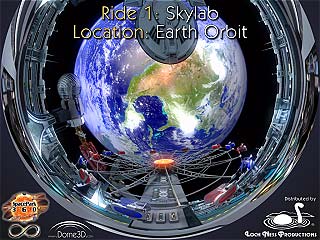 At Loch Ness Productions, collaborating with Dome3D is always interesting. They are wonderful animators with very imaginative visions. We spent four years working with them on SpacePark360: Infinity, anticipation building as each ride was delivered to us for soundtrack work. We never quite knew what to expect, but we were always delighted with the results. Mark was able to take the visuals as inspiration to make some very different and rockin’ Geodesium music to enhance the rides.
At Loch Ness Productions, collaborating with Dome3D is always interesting. They are wonderful animators with very imaginative visions. We spent four years working with them on SpacePark360: Infinity, anticipation building as each ride was delivered to us for soundtrack work. We never quite knew what to expect, but we were always delighted with the results. Mark was able to take the visuals as inspiration to make some very different and rockin’ Geodesium music to enhance the rides.
We asked Dome3D about their choice of Mark for the music. They had selected him for the first SpacePark360: Geodesium Edition show, after Matt Mascheri and Mark had discussed music at a conference. “Mark’s Geodesium music and brand are well known in the planetarium community and it has been great to offer his music in our show,” said Matt. It has given instant credibility and recognition since the Geodesium music tracks are available as well.”
During the production process, Mark would send test mixes to the Dome3D team for their input and approval. Several times, such as with “Ice Slide” and “Sitarnia”, they were blown away by what he had produced. We talked with them about how they were able to create the “hit points” for each ride even before the music was conceived of.
Jason Heaton explained their process. “This was a very fun part of creating the show,” he said. “We actually picked popular music that we liked when we were creating rides. We animated the rides to fit high and low points of the music. Each ride is in fact that exact length of those secret songs. But, we kept them secret, so as not to influence the musical artist.”
As test render videos arrived here at our studios, Mark analyzed them, using the scenes and specific hit points for inspiration. “Often we first approach the ride from afar, to see what’s in store for us, then we get on board and take off,” Mark said. “Then, halfway through, there’s usually a pause or break, and then we take a second lap around the ride — sometimes facing backward. So most of my pieces for this show reflect that: with a somewhat slowed intro, then the main first verse, then the embellished version on the turnaround.”
Mark fashioned the music for each ride to reflect and embellish some of the specific visual elements Dome3D built in, such as special sound effects for when the ride goes through an ice tunnel or enters a crystalline cave in an asteroid.
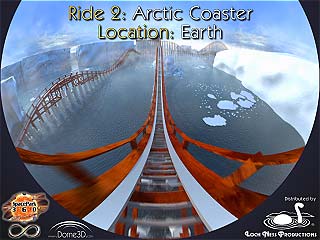 “The soundtrack of a show is equally as important as than visuals, I feel. It creates a mood, sets the scene, and partners with the visuals to give audiences a very rich experience,” he said. “The choreography — making the music match the movement — that’s something audiences notice only if it’s off. Otherwise, it’s integral to the experience.”
“The soundtrack of a show is equally as important as than visuals, I feel. It creates a mood, sets the scene, and partners with the visuals to give audiences a very rich experience,” he said. “The choreography — making the music match the movement — that’s something audiences notice only if it’s off. Otherwise, it’s integral to the experience.”
He used one of the rides, called “Polar Vortex”, as an example. It’s an old-fashioned wooden roller coaster set on the frozen, windswept ice fields of the Arctic, which as Mark points out, made composition a bit tricky. “The first go-round is pretty fun”, he said. “But on the second trip around, the sun sets and the glowing aurora borealis appears, painting the night skies and icescapes green. I had originally planned to use only pretty shimmering sounds and leave out the drums for this part of the scene. However, as delicate and gossamery as the northern lights are in the show, we’re still lurching and banking on a wild ride underneath them, so those drums simply proved to be essential! I settled for making the melody quartet voicing smoother and gentler for the night lap.”
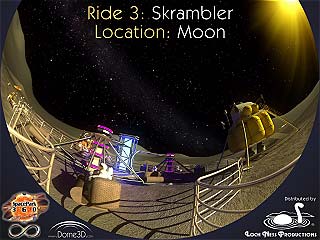 Another ride, called “Skrambler” is incredibly busy, requiring a lot of action both visually and aurally. “This one kicks out the jams,” he said. “But, we still haven’t gone very far out into space — only to an Apollo landing site on the Moon, with Earth still in the sky. So the music stays with the familiar major harmonies and melodic lines to keep us “grounded”.
Another ride, called “Skrambler” is incredibly busy, requiring a lot of action both visually and aurally. “This one kicks out the jams,” he said. “But, we still haven’t gone very far out into space — only to an Apollo landing site on the Moon, with Earth still in the sky. So the music stays with the familiar major harmonies and melodic lines to keep us “grounded”.
Mark often takes his inspirations from past work, as well as present sounds. He reminisced about the inspirations for the moon music in “Skrambler”. “Back in the ’80s, I created soundtrack music for a planetarium show called ALL SYSTEMS GO!, celebrating the 25th anniversary of NASA. The high point was the Apollo 11 landing,” he said. “Since the SpacePark360 ride is set on the Moon with Apollo hardware on the surface, I thought it might be useful to reprise a feel of some of those melody lines for this ride. At least some old planetarians might appreciate the reference, anyway.”
The ride “Sitarnia”, which the Dome3D folk describe as being inside a geode, inspired Mark to reach out for a kind of late ’60s vibe. “The Dome3D guys came up with this wildly colored cave interior, with lots of pink and yellow and purple glowing crystals,” he said. “It looks psychedelic and tie-dyed; like spelunking on acid. So I took a cue from the Beatles, and came up with an Indian-tinged romp, with sitars, wind chimes, and a modal melody. When Carolyn heard a preliminary mix, she opined, ‘It needs finger cymbals’. She lent me her belly-dancing zills so I could lay in some tracks of finger cymbals. All the way though I had this mental image of a couple of Hare Krishna guys there on the sidelines.”
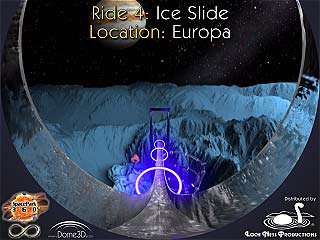 For the “Ice Slide” ride, Mark created a lush mix of music and sound effects that enhanced the ride experience. “The ride takes you down a luge run on Europa, through tunnels, leaping off jumps, all ‘powered’ by these arching, glowing sets of rings,” he said. “When the ride is out in the clear, you hear the music and effects shimmer along. We can hear each ring whoosh by. But, when we go into a tunnel, the mix turns hollow and echo-y, because we’re in a tunnel. This ride is most effective in theaters with surround sound.”
For the “Ice Slide” ride, Mark created a lush mix of music and sound effects that enhanced the ride experience. “The ride takes you down a luge run on Europa, through tunnels, leaping off jumps, all ‘powered’ by these arching, glowing sets of rings,” he said. “When the ride is out in the clear, you hear the music and effects shimmer along. We can hear each ring whoosh by. But, when we go into a tunnel, the mix turns hollow and echo-y, because we’re in a tunnel. This ride is most effective in theaters with surround sound.”
For the IMERSA 2015 Summit, Mark used “Ice Slide” to demonstrate different mixes, to show attendees how important it is to treat a soundtrack as an equal, contributing partner to a fulldome show. “The reality and virtuosity of a ride comes not just from the visuals, which are gorgeous and intricate,” he said, “but also from the music and sound, and the interplay of those with the visualizations,” he said. “For the demonstration at IMERSA, I began with a stereo mix, and it was obvious right away that you lose all the extra work I did to place objects in the sound field. It’s an okay mix, and for most theaters, that’s the sound you’re going to get. Not every theater has surround sound capability.”
For the second part of his demo, Mark played a simulated 5.1 mix, followed by a real 5.1 mix. The differences were immediately apparent, and audience members clearly heard the placement of sounds and the clarity of the mix.
“It was a eureka moment for many people,” he said. “We get so focused on visuals that we sometimes forget how big of a role the soundtrack plays in a show. Festivals seldom recognize the soundtrack artistry, which is too bad. As my mentor Jim Sharp used to say, ‘Audiences come into our theaters with two eyes and two ears. All four should be treated equally.'”
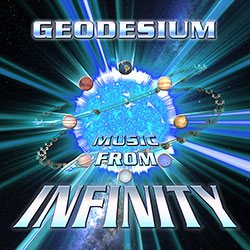 Loch Ness Productions has released an album of the show’s pieces called Geodesium: Music from Infinity. You can read more about his analysis and work on the SpacePark360: Infinity soundtrack on the album’s “In Depth” page.
Loch Ness Productions has released an album of the show’s pieces called Geodesium: Music from Infinity. You can read more about his analysis and work on the SpacePark360: Infinity soundtrack on the album’s “In Depth” page.
Part 1: Visualizing SpacePark360: Infinity
Part 2: Auralizing Space Park 360: Infinity

